
Catalog excerpts
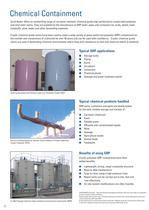
Scott Bader offers an outstanding range of corrosion resistant, chemical grade high performance unsaturated polyester and vinyl ester resins. They are suitable for the manufacture of GRP tanks, pipes and containers for acids, alkalis, fuels, foodstuffs, wine, water and other demanding materials. Crystic chemical grade resins have been used to make a wide variety of glass reinforced polyester (GRP) components for the transfer and containment of chemicals for over 50 years and can be used with confidence. Crystic chemical grade resins are used in demanding chemical environments where...
Open the catalog to page 2
Scott Bader has supplied polyester resins to GRP pipe and pipe liner manufacturers for over 40 years. Much of the early development with GRP pipes was for applications in chemical plants. Filament winding and centrifugal casting techniques have been developed to produce lightweight, low maintenance GRP pipes efficiently and effectively. > A complete range of proven Crystic products is offered for piping and lining applications including isophthalic and vinyl ester resins for sewage and water carrying pipes. > Trenchless sewer repairs using the KM INLINER systemused successfully throughout...
Open the catalog to page 3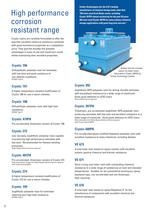
Forbes Technologies Ltd, the U.K's leading manufacturer of chemical storage tanks state that:"We have used Scott Bader resins, including Crystic 397PA almost exclusively for the past 30 years. We have used Crystic 397PA for many arduous chemical storage applications with great long term success." Crystic resins are carefully formulated to offer thespecifier excellent chemical resistance combined with good mechanical properties at a competitive price. They give the moulder the greatest advantages in ease-of-use and mould turn-round whilst maintaining their excellent properties. > Bottom tank...
Open the catalog to page 4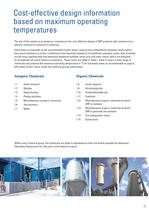
The aim of this section is to assist our customers in the cost-effective design of GRP products with resistance to a specific chemical or mixtures of chemicals.Information is presented on the recommended Crystic resins, ranging from orthophthalic polyester resins (which have good resistance to acidic conditions) to the improved resistance of isophthalic polyester resins. Also available are the more sophisticated and expensive bisphenol modified resins and vinyl ester resins, which are designed for exceptional all-round chemical resistance. These resins are listed in Table I. Table II covers...
Open the catalog to page 5
The Maximum Operating Temperatures for chemical-resistant Crystic resin laminates in various environments have been determined from a number of sources including case histories, laboratory tests and practical experience in various parts of the world.Provided that the GRP structure is manufactured to high standards and in the case of chemical tanks, designed in accordance with the requirements of BS 4994:1987 with full post-cure, the design life period will be ensured. Some GRP tanks made with Crystic polyester resin have already operated for over 12 years within our recommended temperature...
Open the catalog to page 6
High reactivity Isophthalic - C199 Bisphenol polyester C600/novolac CVE 673Isophthalic NPG - C397 Epoxy vinyl ester - VE 676 Isophthalic NPG - C392 Medium reactivity Isophthalic - C274 Medium reactivity Orthophthalic - C197 Low reactivity Isophthalic - C272 Low reactivity Orthophthalic - C196 > *Scott Bader post-cure5 hours at 80 o C followed by 3 hours at 120 o C 130120110100908070605040 C) ( HDT 12010080706040 Post-cure temperature ( C)Time at post-cure temperature (hr) *316161616 6 size="-1">
Open the catalog to page 7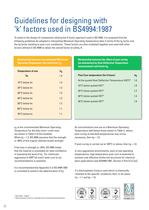
To assist in the design of components utilising the K factor approach used in BS 4994, it is proposed that the following guidelines be adopted in interpreting Maximum Operating Temperature data in terms of the k2 factor and the k5 factor (relating to post-cure conditions). These factors are then multiplied together and used with other factors defined in BS 4994 to obtain the overall factor of safety, K. Relationship between recommended Maximum Operating Temperature (tm) and Factor k2 Relationship between the effect of post-curing (as determined by Heat Deflection Temperature measurement)...
Open the catalog to page 8
Post cured HDT (1.8 MPA stress) Post-cured 19672 > C 19777 > Higher temperature resistant C196 type resin C110 198474PA > High heat resistanceThixotropic pre-accelerated version of Crystic 198Good resistance to acidic conditions, low taint C110 > C > HDT 27275 > Low viscosity, high performance resin with low taint. (Particularly suitable for filament winding)Very high heat resistance C130 > Thixotropic pre-accelerated version of Crystic 272 75 > C491PA > Higher temperature resistant C272 type resin 84 > C274199 > C > 39290 > Tough with exceptional resistance to a wide range of chemicals....
Open the catalog to page 9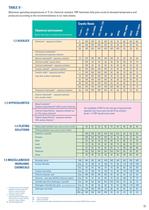
Barrier layer side is in contact with environment 272 / 491PA / 274199392397PA600E / 600PAVE673VE676 / VE671 198 / 474PA196 / 197% conc Ammonia > 2 -aqueous solution 5 NR NR 25 NR 30 35 60 60 60 28 NR NR NR NR NR NR 35 35 35Ammonium hydroxide > 2 - see Ammonia aqueous solution 20 NR NR NR NR 25 30 50 50 50 Barium hydroxide > 2 - aqueous solution 10 NR NR NR NR NR 25 30 50 50 Calcium oxide > 2 (quick lime) NR 25 35 30 45 50 60 70 70 Calcium hydroxide > 2 - aqueous solution NR 25 35 30 45 50 60 70 70 Caustic potash > 2 - aqueous solution 30 NR NR NR NR 35 40 50 55 55 Caustic soda > 2 -...
Open the catalog to page 11
Barrier layer side is in contact with environment 272 / 491PA / 274199392397PA600E / 600PAVE673VE676 / VE671 198 / 474PA196 / 197% conc
Open the catalog to page 12
Barrier layer side is in contact with environment 272 / 491PA / 274199392397PA600E / 600PAVE673VE676 / VE671 198 / 474PA196 / 197% conc De-ionized 100 40 50 45 65 65 80 90 80 80 Sea 45 55 50 70 70 85 95 80 80 > 1. A resistant veil such as saturated polyester should be used in the surface in contact with this chemical, in place of glass. 2. A resistant veil such as polyacrylonitrile should be used in the surface in contact with this chemical, in place of glass. Use polyproplyene liner. NR = Not recommended NA = Data not available ▲ > Concentrations (by weight unless otherwise stated)...
Open the catalog to page 13All Scott Bader Company Limited catalogs and technical brochures
-
Crestabond® M1-60
3 Pages
-
Crestabond® M1-30
3 Pages
-
Crestabond® M1-20
3 Pages
-
Crestabond® M1-05
8 Pages
-
Ancilliaries and Reinforcements
28 Pages
-
Bonding Paste Brochure
4 Pages
-
European Product Guide
20 Pages
-
Closed Mould Brochure
4 Pages
-
Crystic Handbook
100 Pages
-
Crystic Mouldguard brochure
4 Pages
-
Gelcoat Flyer
2 Pages
-
Crystic Gelcoat 967 Excel
2 Pages





























